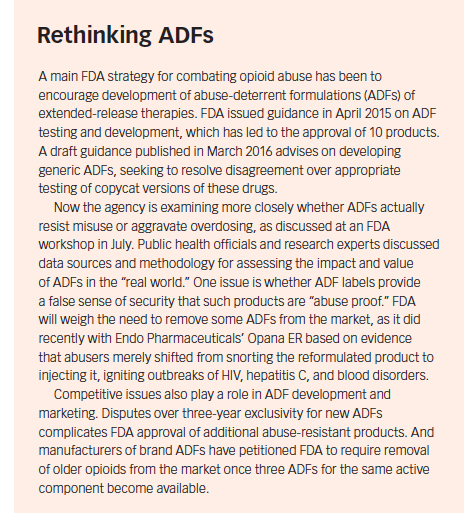Pressure Mounts on FDA, Pharma to Tackle Opioid Abuse
Pharmaceutical Executive
The growing toll requires new assessment of risks, expanded provider education, and more scrutiny of marketed products.
The steady rise in deaths, injuries, and treatment costs related to the abuse and misuse of opioid painkillers has increased calls for FDA and drug companies to more forcefully limit use of harmful medicines while ensuring access to effective analgesics for patients suffering from pain. With the opioid epidemic linked to some 180,000 overdose deaths between 2000 and 2015, public health officials are demanding more effective
Jill Wechsler

action to curb the prescribing and dispensing of some 200 million pain pills to Americans each year. Federal and state health officials, moreover, seek to prevent further opioid diversion and to expand treatment of addicts to prevent overdoses and to better educate health professionals on appropriate opioid prescribing and dispensing.
Lawsuits and settlements
The escalating crisis is drawing attention of Congressional committees and federal and state prosecutors to the role of pharmaceutical companies in promoting opioid prescribing. The Department of Justice recently reached a $35 million settlement with Mallinkrondt Pharmaceuticals to resolve allegations of failing to track or report the apparent diversion of millions of pain pills. And former sales executives at Insys Therapeutics have pled guilty to violating the federal anti-kickback statute by inducing physicians to prescribe its fentanyl spray Subsys beyond its approved use of treating serious short-term cancer pain.
More than 25 states, cities, and counties have filed charges that opioid producers allegedly downplayed the addictive nature of these pain meds. A California lawsuit claims that Endo and Perdue Pharma knew that their abuse-deterrent formulations (ADFs) could be abused, but hid that information. Some states are considering taxes on pharma company opioid sales and examining industry efforts to block states from setting limits on pill dispensing or prescribing. And high prices for overdose antidotes such as naloxone are attracting scrutiny.
The legal action may increase as states seek resources to fund drug abuse programs cut by tight Medicaid funding, as discussed at a recent hearing before the House Energy & Commerce Oversight & Investigations subcommittee on state initiatives to prevent and treat opioid addiction. The Senate Homeland Security and Governmental Affairs Committee is investigating opioid drug diversion, including the failure of drug wholesalers to identify excessive shipments and the obligations of manufacturers to track and report suspicious activity by distributors, doctors, and pharmacies. Congress is considering a range of legislative proposals for curbing opioid use, including expanded physician training on prescribing of pain therapies and limits or caps on opioid prescribing and dispensing. And the HHS Inspector General is examining excessive opioid use by Medicare patients and physicians with questionable prescribing patterns.
New framework
A main issue is whether FDA appropriately evaluates new pain medicines for market and does all it can to prevent excess opioid prescribing and distribution. A new report from The National Academies of Sciences, Engineering and Medicine (NASEM), which FDA requested as part of its February 2016 opioid action plan, outlines a “public health” framework for FDA review of new pain treatments (view here). In weighing the risks and benefits of medicines for treating serious pain, the experts want FDA to consider clearly a drug’s impact on families and communities and the risk of abuse and addiction and of diversion to illicit markets.

The panel urges FDA to release summary versions of complete response letters to ensure transparency in decision-making and calls for stronger FDA post-approval oversight, with periodic evaluations of marketed products to ensure continued safe and appropriate use. Following a full “re-review” of all marketed opioids, those medicines found to raise high risks should be withdrawn from the market.
A controversial proposal is to restrict opioid advertising and promotion to “responsible” messages that include public health issues, to be outlined in new FDA guidance. Off-label marketing would be prohibited, and direct-to-consumer (DTC) broadcast advertising limited. And while the expert panel supports mandatory education for all health professionals on pain management and opioid use, the role of pharma in supporting provider education is open for discussion.
Many of the NASEM recommendations are similar to initiatives announced by FDA commissioner Scott Gottlieb to update FDA’s response to the opioid crisis. Gottlieb and Janet Woodcock, director of the Center for Drug Evaluation and Research (CDER), outlined a quantitative framework for assessing opioid product risks, as seen in the NASEM report recommendation, in an article posted by the Journal of the American Medical Association (JAMA) on July 6.
Gottlieb opened last month’s workshop on evaluating opioid ADFs by urging a “fresh look” at how FDA balances patient access to appropriate painkillers with efforts to ensure public safety. He announced an update to the opioid risk evaluation and mitigation strategy (REMS) for extended-release opioids to also cover immediate-release products, which account for more than 90% of pain prescriptions. Gottlieb also expanded provider training under the REMS to a broader range of health professionals and raised the possibility of making such provider education mandatory. A new FDA Opioid Policy Steering Committee

headed by deputy commissioner Rachel Sherman will examine that issue, as well as the impact of limits or caps on pills and prescriptions and FDA’s consideration of risk of abuse in evaluating new drug applications.
The ultimate solution to opioid misuse is to replace these dangerous therapies with more effective, non-addictive pain medicines. Experts question whether newer extended-release opioids are really beneficial or actually worsen pain. The National Institutes of Health has formed a public-private partnership to speed development of new pain therapies and addiction treatments, including opioids with less euphoric effect and fewer side effects for chronic pain patients. There’s growing excitement over experimental drugs and gene therapies that block nerve pathways of pain and hope that precision medicine may lead to tailored pain treatments for individuals.
Jill Wechsler is Pharmaceutical Executive’s Washington Correspondent. She can be reached at jllwechsler7@gmail.com

Navigating Distrust: Pharma in the Age of Social Media
February 18th 2025Ian Baer, Founder and CEO of Sooth, discusses how the growing distrust in social media will impact industry marketing strategies and the relationships between pharmaceutical companies and the patients they aim to serve. He also explains dark social, how to combat misinformation, closing the trust gap, and more.
Pfizer, GSK Gain ACIP Recommendations for RSV and Meningococcal Vaccines
April 18th 2025The Centers for Disease Control and Prevention’s Advisory Committee on Immunization Practices voted to expand access to Pfizer’s respiratory syncytial virus vaccine Abrysvo for high-risk adults in their 50s and voted in favor of GSK’s meningococcal vaccine, Penmenvy, for streamlined adolescent protection.